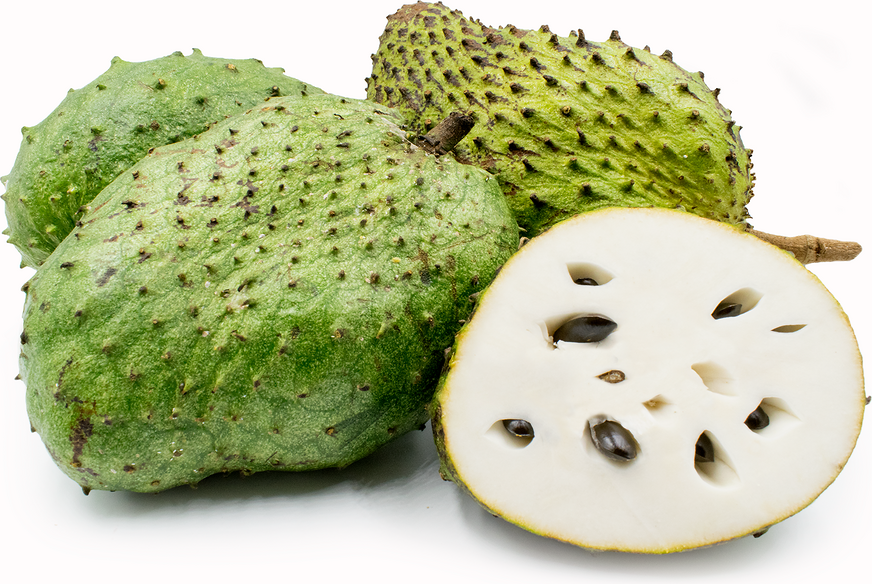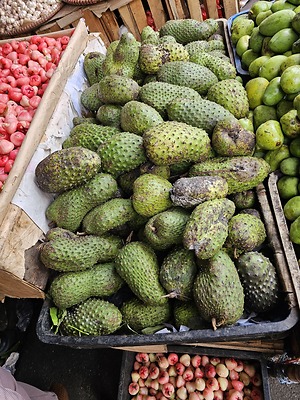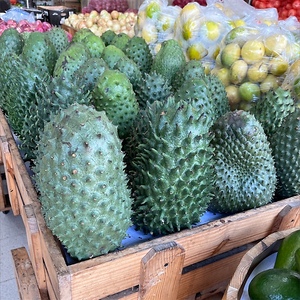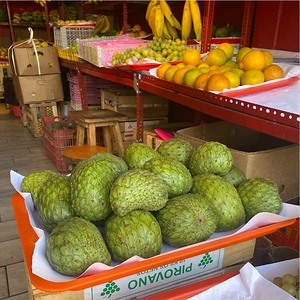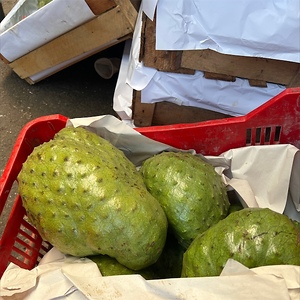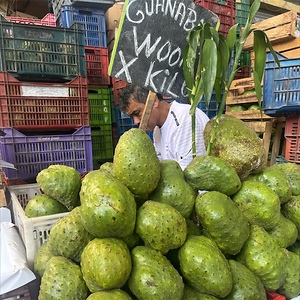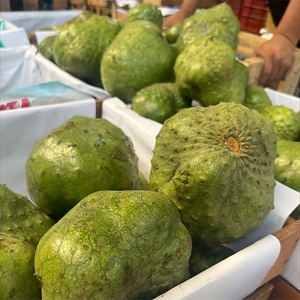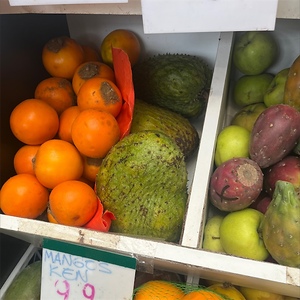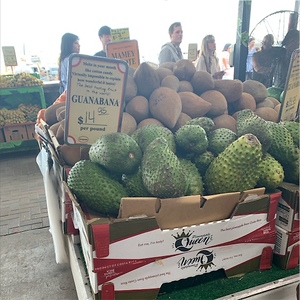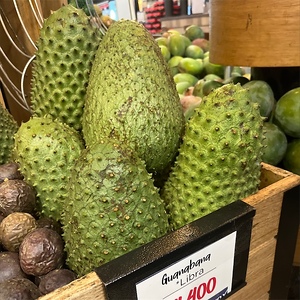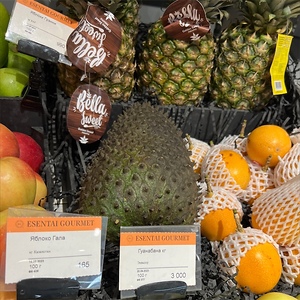The Guanabana (pronounced gwuh-nah-buh-nuh) is a large, crooked heart-shaped fruit with small spike-like protrusions. The skin is dark-green and turns slightly yellowish-green when ripe. When ready to eat the fruit is very soft to the touch, and begins to break down quickly. The white flesh is custard-like and sweet; the juicy, segmented pulp contains large black seeds. The aroma has been likened to a pineapple or banana, with a uniquely acidic flavor. The shelf-life of this fruit is only a few days at room temperature.
The Guanabana is available year-round, with peak seasons from winter to late fall in various regions of the tropics.
The Guanabana is also known as the Soursop or the Graviola. It is in the genus Annona, and is related to the Sugar Apple and Cherimoya. The fruit is said to be a natural remedy against cancerous cells.
Guanabana can be used to fight against bacterial and fungal infections. It is said to be effective at lowering high blood pressure and aiding in depression, stress and nervous disorders. Tea made from the leaves of the Guanabana tree is used as a sleep aid in Trinidad. The seeds are toxic and should be removed before ingesting the pulp or before juicing.
The Guanabana is most typically used to make a sweet beverage. The fruit is ideal for processing and preservation. The pulp is pushed through a sieve or cheesecloth and the resulting juice is mixed with milk or water and sweetened. The juice can be used to make ice creams, sorbets, mousse, or custards; it also makes a nice cocktail when mixed with alcohol. The pulp can be frozen and eaten or used to create jellies, syrups or nectar.
The Guanabana is made into a carbonated beverage and commercially processed in Puerto Rico. In the West Indies, it is fermented and made into a cider-like drink. In the Philippines it is called guayabano and sold as a vacuum-concentrated juice that is dyed pink or green to make it's milky color more appealing. Various parts of the Guanabana tree have been used for centuries by medicine men and native Indians in South America to treat ailments such as heart disease, asthma, liver problems and arthritis.
The Guanabana was first written about in the 16th century, during which time it was abundant in the West Indies and the northern parts of South America. The Guanabana tree was one of the first fruit trees taken from the Americas to the Old World Tropics. Since then, it can be found in Australia, southern China, Vietnam, and the Pacific Islands. It thrives in the Dominican Republic and is one of the most popular fruits in Cuba, Puerto Rico, the Bahamas, Colombia and northeastern Brazil. It can also be found growing in Hawaii and southern Florida. In 1951 a Professor in Puerto Rico who was encouraging the development of the Guanabana told a professor of agriculture in the United States that he wanted to adopt a different name for the fruit in the US. He didn’t think the name soursop was very appealing and was concerned Guanabana was too difficult to pronounce. To this day, a better name has not been found.
Recipes that include Guanabana. One
Guanabana
09/22/2024
View Notes
Soursop, also known as Guanabana, has a distinctive heart-shaped appearance with a dark-green skin and small spike-like protrusions. When ripe, it turns slightly yellowish-green and becomes incredibly soft, signaling readiness for consumption. Its custard-like white flesh is juicy and sweet, carrying large black seeds. With an aroma resembling pineapple or banana, its unique acidic flavor stands out, though its shelf-life at room temperature is just a few days.
Guanabana
09/06/2024
View Notes
Surtidiros JJ
(314) 678-6272
Guanabana: The Guanabana's pulp is highly versatile, making it ideal for various culinary creations. It is commonly transformed into a sweet juice, mixed with milk or water, and sweetened. The juice can enhance ice creams, sorbets, mousse, custards, and alcoholic cocktails. Additionally, the frozen pulp can be directly consumed or utilized in crafting jellies, syrups, or nectar dishes.
Guanabana
05/15/2024
View Notes
Mercado Risso
Jirón José Pezet y Monel 2080, Lince 15073
Guanabana: This fruit, also known as Soursop or Graviola, is in the Annona genus and shares a relation with Sugar Apple and Cherimoya. Its pulp is believed to fight bacterial and fungal infections, support blood pressure regulation, and aid in managing depression and stress. While its leaves are used for sleep-aiding tea in Trinidad, caution is advised with its seeds, as they are toxic and must be removed.
Guanabana
05/10/2024
View Notes
The Guanabana tree, originating from the Americas, was among the first fruit trees brought to the Old World Tropics. Now globally distributed, it thrives in areas like the Dominican Republic, Cuba, Colombia, and northeastern Brazil, as well as Hawaii and southern Florida. Though widely loved, naming has been a challenge; efforts in the 1950s to replace "soursop" or "Guanabana" with a more appealing term were unsuccessful, and the search for a better name remains ongoing.
Guanabana
05/10/2024
View Notes
Guanabana: This tropical fruit is creatively repurposed around the world. In Puerto Rico, it becomes a carbonated beverage, while in the West Indies it is fermented into a cider-like drink. The Philippines transforms it into a vacuum-concentrated juice, dyed pink or green to enhance visual appeal. Traditionally, South American medicine men used its tree parts to address conditions like heart disease, asthma, liver issues, and arthritis.
Guanabana
05/10/2024
View Notes
Guanabana: This tropical fruit has a distinctive dark-green, slightly spiked exterior that turns yellowish when ripe. Its soft, custard-like white flesh is both sweet and tangy, combining notes of pineapple and banana. Inside, you'll find juicy, segmented pulp with large black seeds. Be sure to consume it quickly, as its shelf life at room temperature lasts only a few days.
Guanabana
05/01/2024
View Notes
Mercado San Isidro
Av. Augusto Pérez Araníbar, San Isidro 15076, Peru
Guanabana: The Guanabana pulp is incredibly versatile, commonly sieved to produce juice that pairs well with milk, water, or sweeteners for refreshing drinks. This juice is a base for ice creams, sorbets, mousse, and custards, or it can enhance cocktails with alcohol. The frozen pulp serves as a treat itself or can be transformed into jellies, syrups, and nectar, demonstrating its adaptability in culinary applications.
Guanabana
04/04/2024
View Notes
Guanabana: Also called Soursop or Graviola, the Guanabana belongs to the genus Annona and is related to the Cherimoya and Sugar Apple. It's valued not only for its unique taste but also for its potential health benefits, like fighting bacterial and fungal infections, lowering blood pressure, and alleviating stress or depression. While its leaves are used for tea as a sleep aid, be cautious with its seeds, as they are toxic.
Guanabana
01/27/2024
View Notes
Euro supermercado Jardines De Llanogrande
Km8, Via Don Diego, Llanogrande Rionegro Antioquia
0344440366
The Guanabana, also known as soursop, is a fruit with a long history, first documented in the 16th century when it was abundant in the West Indies and northern South America. It was one of the first fruit trees to be introduced from the Americas to the Old World Tropics. Today, it thrives in areas like the Dominican Republic, Cuba, Puerto Rico, and northeastern Brazil, as well as in Hawaii and southern Florida, though its ideal name is still debated.
Guanabana
09/24/2023
View Notes
Esentai gourmet
Al pharabi avenue 77, Almaty, Kazakhstan
The Guanabana tree has been valued for centuries in South America for its medicinal properties. Medicine men and native Indians used various parts of the tree to address ailments such as heart disease, asthma, liver issues, and arthritis. In global contexts, its fruit is enjoyed in different forms, like a cider-like drink in the West Indies and vacuum-concentrated juice in the Philippines, often dyed to enhance its appeal.
View Full Share Market®


